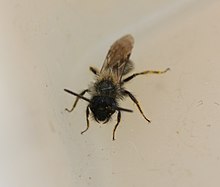
Philanthus triangulum, commonly known as the European beewolf, bee-killer wasp or the bee-eating philanthus, is a solitary wasp that lives in the Western Palearctic and Afrotropics. Although the adults of the species are herbivores, the species derives its name from the behaviour of the inseminated females, who hunt Western honey bees. The female places several of its paralysed prey together with an egg in a small underground chamber, to serve as food for the wasp larvae. All members of the genus Philanthus hunt various species of bees, but P. triangulum is apparently the only one that specialises in Western honey bees.
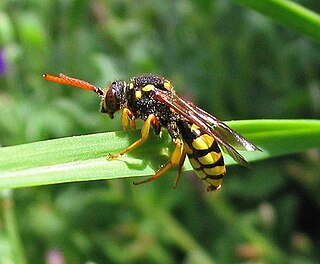
With over 850 species, the genus Nomada is one of the largest genera in the family Apidae, and the largest genus of kleptoparasitic "cuckoo bees." Kleptoparasitic bees are so named because they enter the nests of a host and lay eggs there, stealing resources that the host has already collected. The name "Nomada" is derived from the Greek word nomas (νομάς), meaning "roaming" or "wandering."
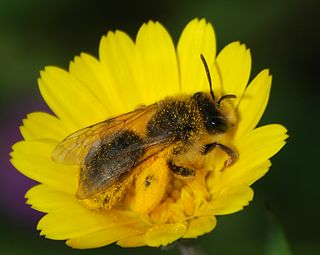
Andrena, commonly called the mining bee, is the largest genus in the family Andrenidae, and is nearly worldwide in distribution, with the notable exceptions of Oceania and South America. With over 1,300 species, it is one of the largest of all bee genera. Species are often brown to black with whitish abdominal hair bands, though other colors are possible, most commonly reddish, but also including metallic blue or green.

Megachile sculpturalis, known as the giant resin bee and sculptured resin bee, is a species of leafcutting bees belonging to the family Megachilidae.

Osmia bicolor, the two-coloured mason-bee, is a Palearctic species of bee in the genus Osmia. It is outstanding amongst other megachilid bees in that it nests in empty snail shells.

The tawny mining bee, Andrena fulva, is a European species of the sand bee (Andrena) genus. The males are 10–12 mm (0.4–0.5 in) and the females 8–10 mm (0.3–0.4 in) long. The female is covered with fox-red hair on the dorsal surface of its thorax and abdomen and black hair on its head and ventral surface. The male is less distinctive, being clad in golden-brown or reddish-brown hairs, with some long white hairs on the face, and a tooth on each of the mandibles.
The willow flower miner bee is a miner bee in the genus Andrena. Another common name for this species is the willow mining bee. The bee ranges from Colorado to California and north to British Columbia, and often inhabits arid and alpine lands. The bee is often black or dark brown, and is sparsely coated with grayish hair on the thorax, legs and on the abdomen. The pollen basket is on most of the hind leg. The wings of the willow flower miner bee are smokey, and their veins are black.
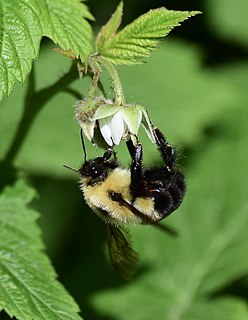
The two-spotted bumble bee is a species of social bumble bee found in the eastern half of the United States and the adjacent south-eastern part of Canada. In older literature this bee is often referred to as Bremus bimaculatus, Bremus being a synonym for Bombus. The bee's common name comes from the two yellow spots on its abdomen. Unlike many of the other species of bee in the genus Bombus,B. bimaculatus is not on the decline, but instead is very stable. They are abundant pollinators that forage at a variety of plants.

Andrena agilissima is a species of mining bee. They are present in most of Europe, the Near East and North Africa and can be found from April through July. Andrena agilissima is an oligolectic species, feeding only on the pollen of a few genera of Cruciferous vegetables.

Andrena hattorfiana is a species of mining bees belonging to the family Andrenidae subfamily Andreninae.
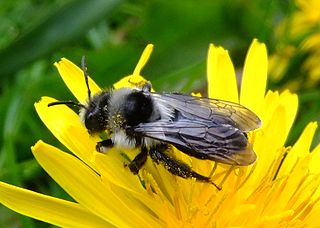
The ashy mining bee or grey mining bee, Andrena cineraria, is a European species of the sand bee (Andrena) genus. Its distinctive colouring makes it one of the most easily recognised of the genus. The females are black, with two broad grey hair bands across the thorax. The male is also black although the thorax is entirely covered with grey hairs. The male has a tuft of white hairs on the lower face and white hairs on all femora while the female has white hairs only on the front femora. The female has twelve segments to their antennae and the male has thirteen.

Lasioglossum leucozonium, also known as Lasioglossum similis, is a widespread solitary sweat bee found in North America, Europe, Asia, and parts of northern Africa. While now a common bee in North America, population genetic analysis has shown that it is actually an introduced species in this region. This population was most likely founded by a single female bee.

Halictus sexcinctus, commonly referred to as the six-banded furrow bee, is a species of sweat bee found throughout Europe and as far east as Asian Turkey and Iraq.The H. sexcinctus can be easily confused with the closely related species, Halictus scabiosae, due to very similar morphological features. H. sexcinctus show a social polymorphism in which different colonies can exhibit solitary, communal, or eusocial structure. Due to this large variance in social organization, it was suspected that it was not one species at all, but rather multiple, cryptic species. However, genetic analysis was able to confirm these varying populations as one species. H. sexcinctus will forage from multiple flower species, but prefers plant species with wide-open flowers. Their nests can be found dug into the ground in loamy or sandy soil.

Andrena scotica, the chocolate mining bee or hawthorn bee, is a species of mining bee from the family Andrenidae. It occurs in western Europe and is one of the most frequently encountered mining bees found in Great Britain, where it had been previously misidentified as Andrena carantonica.

Andrena trimmerana, Trimmer's mining bee, is a species of mining bee from the family Andrenidae. It occurs in the western Palearctic but its true status in some areas is muddled due to issues of taxonomy and misidentification.

Nomada marshamella, Marsham's nomad bee, is a species of Palearctic cuckoo bee which appears to be a wasp mimic and which is cleptoparasite on the mining bees of the genus Andrena, especially A. scotica and A. trimmerana.

Andrena vaga, the grey-backed mining bee, is a species of solitary bee which is found in most of Europe but which is very rare in Great Britain, where it may be recolonizing in the south-east after previously being extirpated. It specialises in feeding on the pollen of willows.
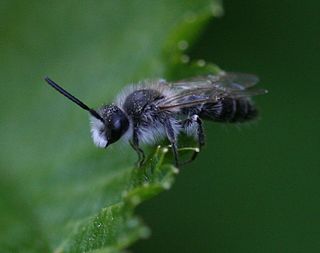
The bearded miner bee is a species of miner bee in the family Andrenidae. It is found in Europe & Northern Asia and North America. Other common names include the long-lipped andrena and the sandpit mining bee.
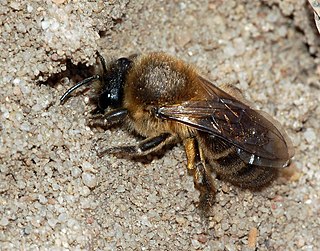
Colletes cunicularius, the vernal colletes or spring mining bee, is a species of solitary bee from the family Colletidae which is widespread in the Palearctic from Britain to the Pacific Ocean which nests in areas of open, sandy soil.

The tormentil mining bee is a species of mining bee from the family Andrenidae which has a Palearctic distribution.

